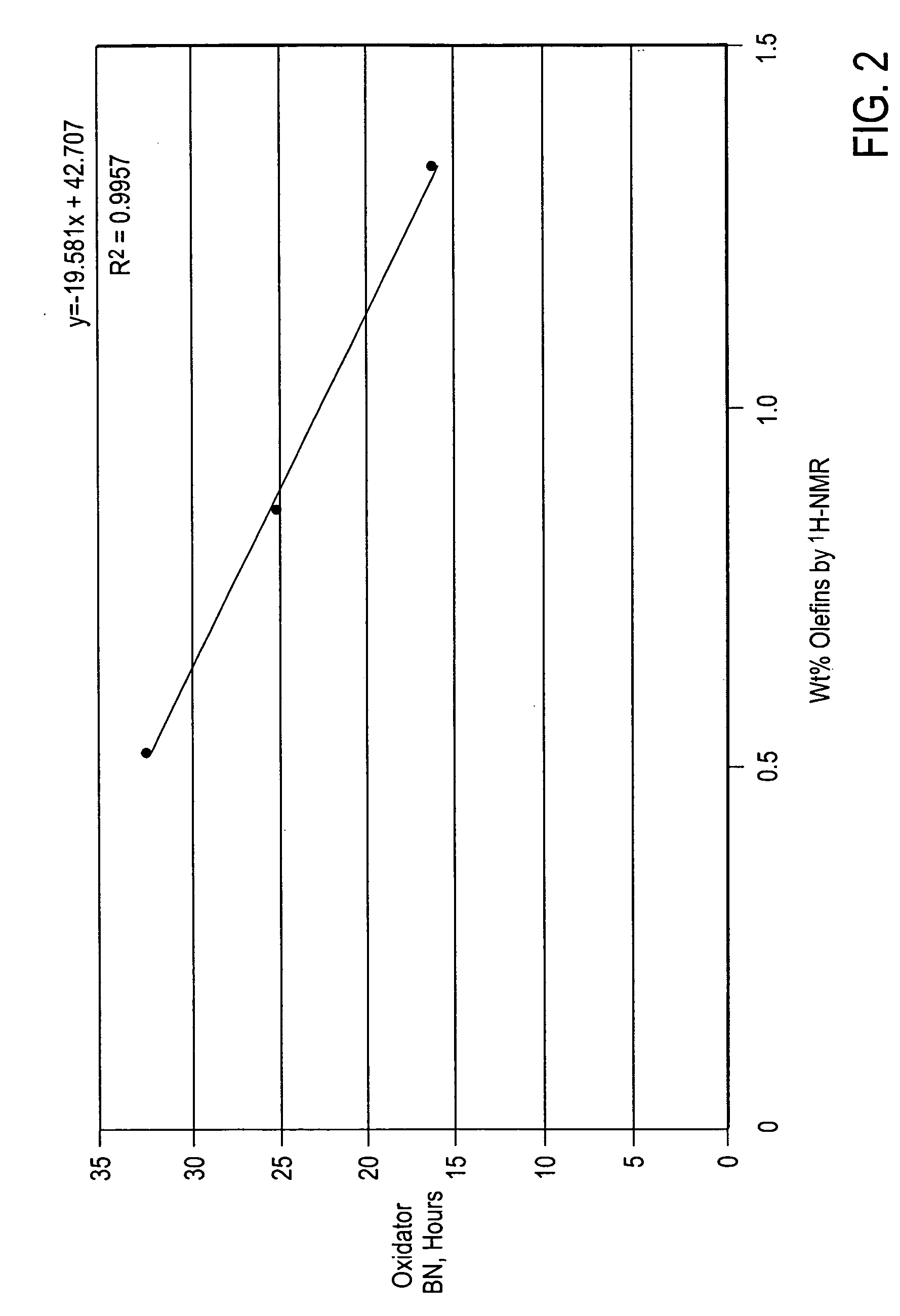Process to enhance oxidation stability of base oils by analysis of olefins using ¹H NMR
a technology of olefin and analysis method, which is applied in the direction of oxygen-containing compound preparation, physical/chemical process catalyst, oxygen compound purification/separation, etc., can solve the problem of limit on olefin determination using sup>1/sup>h nmr, and achieve high oxidation stability, increase methyl branching, and high oxidation stability
- Summary
- Abstract
- Description
- Claims
- Application Information
AI Technical Summary
Problems solved by technology
Method used
Image
Examples
example 1
[0063] A wax sample composed of several different batches of hydrotreated Fischer-Tropsch wax, all made using a Co-based Fischer-Tropsch catalyst, and was prepared. The different batches of wax comprising the wax sample were analyzed and found to have the general properties as shown in Table 1.
TABLE 1Fischer-Tropsch WaxFischer-Tropsch CatalystCo-BasedSulfur, ppmNitrogen, ppmOxygen, wt. %ASTM D 6352 SIMDIST TBP (WT. %), ° F.T10550-700T901,000-1080 T90-T10, ° C.>154
[0064] The Co-based Fischer-Tropsch wax was hydroisomerized over a Pt / SAPO-11 catalyst with an alumina binder. Operating conditions included temperatures between 635° F. and 675° F. (335° C. and 358° C.), LHSV of 1.0 hr−1, reactor pressure of about 500 psig, and once-through hydrogen rates of between 5 and 6 MSCF / bbl. The reactor pressure was kept low, in order to increase the yield of base oil and decrease hydrocracking into lighter boiling products.
[0065] The reactor effluent passed directly to a second reactor contain...
example 2
[0071] Four lubricating base oils were made by oligomerizing Fischer-Tropsch derived olefins over an ionic liquid catalyst. After oligomerization, three of them were hydroisomerized (G, H, and I) over a Pt / SSZ-32 molecular sieve on an alumina support. The hydroisomerization conditions included a total pressure of 1,000 psig, LHSV between 0.5 and 1.0, MSCF / bbl of 4, and temperatures between 600 and 615° F. The hydrofinishing conditions for samples G, H, and I were similar in many respects to the hydroisomerizing conditions. The hydrofinishing catalyst was a Pd / Pt silica alumina hydrofinishing catalyst. The hydrofinishing temperatures were between 450 and 500° F. The hydrofinishing conditions for sample J were more severe. Sample J was hydrofinished over a Pt silica alumina hydrofinishing catalyst at 2,000 psig total pressure, 5 MSCF / bbl, and 500° F. The properties of these four base oils are shown in Table 4.
TABLE 4Oligomerized Fischer-Tropsch Derived Lubricant Base OilsSample IDGH...
example 3
[0073] Three commercial samples of Chevron Phillips polyalphaolefin base oils were analyzed for BI, weight percent olefins by 1H NMR, and oxidation stability by Oxidator BN. These base oils were made by oligomerization of alpha olefins followed by hydrofinishing. The results of these analyses are summarized in Table 5.
TABLE 5Polyalphaolefin Base OilsSample IDKLMPropertiesViscosity at1.7266.9039.021100° C., cStViscosity Index149145Sim Dist TBP608875889(WT. %), ° F. 10%PointMolecular291565667Weight, ASTM D25031H NMR DataForm Olefin H41.2980.4395.0Saturate H43.2982.4397.0Total Integral1622.6544.651021.1div / H37.496.6110.53Olefin integral111Olefin H0.0270.150.10Sample olefin H0.586.244.61Wt. % Olefins by1.337.574.751H NMROxidator BN,40.0725.6229.94hoursBromine Index41918573
[0074] The results illustrate that the weight percent olefins by 1H NMR and oxidation stability results were again strongly correlated. The data show that with a R2=0.9989, the oxidation stability of the polyalphaole...
PUM
| Property | Measurement | Unit |
|---|---|---|
| wt. % | aaaaa | aaaaa |
| wt. % | aaaaa | aaaaa |
| pressure | aaaaa | aaaaa |
Abstract
Description
Claims
Application Information
 Login to View More
Login to View More - R&D
- Intellectual Property
- Life Sciences
- Materials
- Tech Scout
- Unparalleled Data Quality
- Higher Quality Content
- 60% Fewer Hallucinations
Browse by: Latest US Patents, China's latest patents, Technical Efficacy Thesaurus, Application Domain, Technology Topic, Popular Technical Reports.
© 2025 PatSnap. All rights reserved.Legal|Privacy policy|Modern Slavery Act Transparency Statement|Sitemap|About US| Contact US: help@patsnap.com


